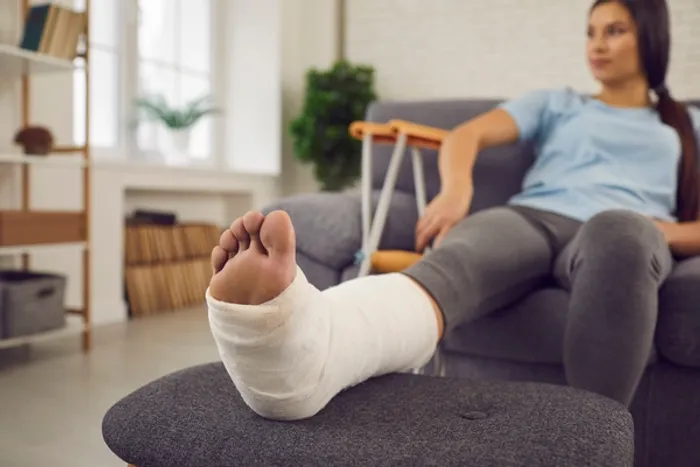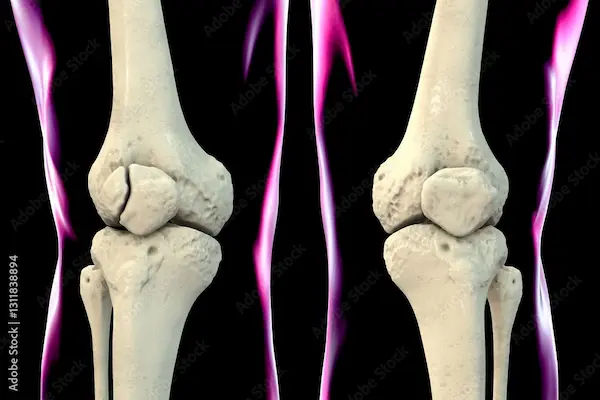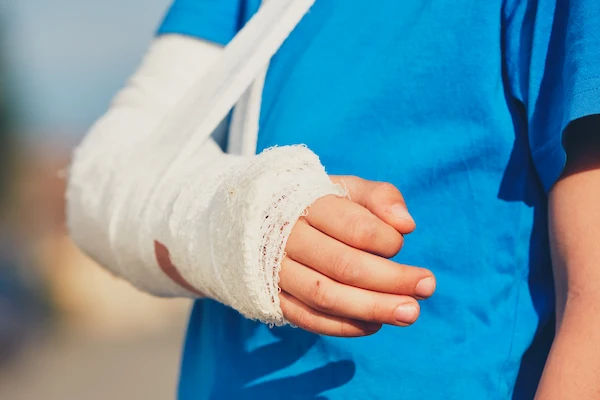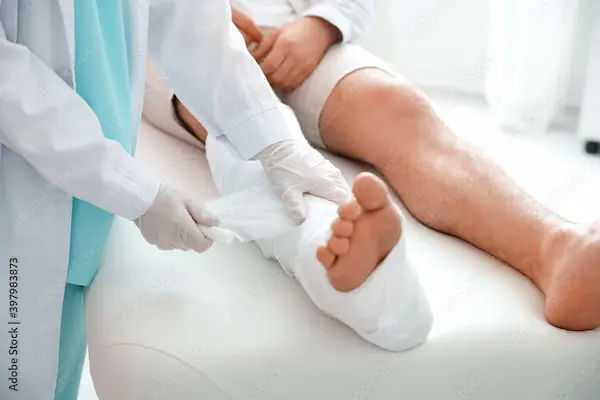Bone Fracture First Aid: Your Complete Guide to Immediate Care & Recovery
Discover how to handle bone fractures with the right first aid kit essentials, effective home care practices, and what to expect during recovery.


Introduction
A sudden fall, a sports mishap, or an unexpected accident—a bone fracture can happen in an instant, turning an ordinary day into a painful emergency. In those critical first moments, knowing what to do (and what not to do) can significantly impact healing time and prevent further injury. This comprehensive guide is designed to be your go-to resource for bone fracture aid. We’ll walk you through the essential steps of emergency first aid, show you how to build a dedicated first-aid kit, and detail what to expect during the often challenging recovery process at home. Whether you're preparing for the unexpected or navigating a recent injury, this knowledge empowers you to act confidently and support optimal healing.
Is It a Break or a Sprain? Recognising Fracture Symptoms
Before you can provide effective bone fracture aid, you need to recognise the signs. While both breaks and sprains cause pain and swelling, fractures have distinct indicators.
Common Signs of a Fractured Bone
A fracture often presents with a combination of the following symptoms:
- Intense Pain: The pain is usually severe and worsens with any movement or pressure.
- Visible Deformity: The limb or joint may look bent, twisted, or out of place in a way that a sprain typically does not cause.
- Swelling and Bruising: These appear rapidly around the injury site.
- Inability to Bear Weight: You cannot put any weight on the injured area without significant pain.
- Grating Sensation: A feeling of grating or grinding (crepitus) when the injured area is moved.
- Numbness or Tingling: This can indicate nerve involvement or pressure from swelling.
Fracture vs. Sprain: Key Differences
- The main difference lies in the structure affected. A sprain involves the stretching or tearing of ligaments (connecting bones), while a fracture is a break in the bone itself. A key differentiator is the location of tenderness. If the pain is directly over the bone, it's more likely a fracture. If it's in the softer tissue of the joint, it may be a sprain. However, when in doubt, always assume it's a fracture and seek professional medical help. An accurate diagnosis often requires an X-ray, which you can quickly book through services like Apollo24|7.
Consult an Orthopaedist for the best advice
Your Step-by-Step Bone Fracture First Aid Guide
Acting quickly and correctly is paramount. Follow these steps to provide safe and effective initial bone fracture aid.
Step 1: Call for Emergency Help & Stay Calm
- If the injury is severe, the person is unconscious, or there is heavy bleeding, call your local emergency number (like 108 in India) immediately. Your calmness will help keep the injured person relaxed.
Step 2: Stop Any Bleeding and Assess the Situation
- If there is bleeding, apply gentle pressure with a sterile gauze or a clean cloth. Do not attempt to clean a major wound or push in any protruding bone fragments.
Step 3: Immobilise the Injured Area (The Golden Rule)
- This is the most critical step. Do not try to realign the bone. Movement can cause catastrophic damage to nerves, blood vessels, and muscles. Immobilise the area above and below the injury.
DIY Splinting Techniques Using Everyday Items
- If professional help is delayed, you can create a makeshift splint. Use rolled-up newspapers, magazines, a wooden board, or even a sturdy umbrella. Place the splint along the injured limb and secure it with triangular bandages, strips of cloth, or belts. Ensure the ties are firm but not so tight that they cut off circulation.
Step 4: Apply Ice to Reduce Swelling and Pain
- Wrap an ice pack or a bag of frozen vegetables in a thin towel and apply it to the injured area for 15-20 minutes. This reduces swelling and numbs the pain. Never apply ice directly to the skin.
Step 5: Keep the Person Comfortable and Monitor for Shock
- Help the person lie down in a comfortable position, with their head slightly elevated. Cover them with a blanket to maintain body temperature. Watch for signs of shock, such as paleness, clammy skin, or rapid breathing.
Building the Ultimate Bone Fracture First Aid Kit
While a standard first-aid kit is useful, a dedicated trauma add-on kit can be a game-changer for fracture emergencies at home or outdoors.
Essential Medical Supplies for Immobilisation and Wound Care
- SAM Splint: A moldable, lightweight splint that can be shaped to fit any limb.
- Triangular Bandages (x4): Incredibly versatile for making slings, securing splints, and bandaging wounds.
- Conforming Gauze Roll: To wrap and hold splints and dressings in place.
- Sterile Gauze Pads: For covering open wounds.
- Medical Tape: Hypoallergenic tape to secure gauze.
- Antiseptic Wipes: For cleaning minor cuts around the injury.
Helpful Tools and Comfort Items
- Instant Cold Pack: A chemical pack that gets cold instantly without refrigeration.
- Scissors: For cutting tape, gauze, or clothing.
- Emergency Blanket: A compact foil blanket to prevent shock and retain body heat.
- Disposable Gloves: For infection control.
- Pain Relievers: Like acetaminophen (avoid ibuprofen initially if there's heavy bleeding, as it can thin blood).
The Road to Recovery: What to Expect After the ER
Once a doctor has set the fracture and applied a cast or splint, the healing journey begins at home. Proper home care after fracture surgery or casting is vital.
The First 48-72 Hours: Managing Pain and Swelling at Home
- Continue the RICE protocol: Rest, Ice, Compression (as advised by the doctor), and Elevation. Keep the injured limb elevated above the level of the heart as much as possible to dramatically reduce swelling. Take prescribed pain medication as directed.
Long-Term Home Care: Supporting the Healing Process
- Healing is a biological process that you can support. A unique insight often overlooked is the importance of systemic support, not just local care.
Nutrition for Bone Health: Foods That Help Fractures Heal
Your body needs raw materials to rebuild bone. Focus on a diet rich in:
- Calcium: Dairy products, leafy greens, fortified plant-based milk.
- Vitamin D: Essential for calcium absorption. Get sunlight exposure and eat fatty fish or eggs. If you're housebound, Apollo24|7 offers a convenient home collection for vitamin D tests to check your levels.
- Protein: The scaffolding for new bone. Include lean meats, lentils, beans, and tofu.
- Vitamin C: Crucial for collagen formation. Citrus fruits, bell peppers, and broccoli are excellent sources.
Safe Movement and Rehabilitation Exercises
- Follow your doctor's or physiotherapist's instructions meticulously. They will guide you on when to start moving and which rehabilitation exercises for fracture are safe. This prevents muscle atrophy and stiffness in the immobilised joints. Never try to remove a cast or splint yourself.
When to Seek Immediate Medical Attention (Red Flags)
Even after initial treatment, complications can arise. Contact your doctor or use Apollo24|7's online consultation service immediately if you experience:
- Increased pain that is not relieved by medication.
- Numbness, tingling, or a "pins and needles" feeling in the injured limb.
- Fingers or toes turning blue, white, or cold to the touch.
- The cast feels too tight, or swelling increases severely after casting.
- Signs of infection, such as fever, redness, foul odor, or pus from the wound.
- The cast breaks, gets soft, or gets soaked.
Conclusion
Navigating a bone fracture, from the shocking moment of injury through the slow process of recovery, can be a daunting experience. However, being equipped with the right knowledge transforms fear into confidence. By mastering the steps of immediate bone fracture aid, preparing a specialised kit, and understanding the pillars of effective home care—rest, elevation, nutrition, and guided rehabilitation—you actively contribute to a smoother and faster recovery. Remember, your first job is to stabilise and seek professional help. Your role then shifts to being a patient and informed participant in your own healing journey. If you have any concerns at any stage, never hesitate to consult a doctor online with Apollo24|7 for prompt advice and peace of mind.
Consult an Orthopaedist for the best advice
Consult an Orthopaedist for the best advice

Dr. Manoj Dinkar
Orthopaedician
15 Years • MBBS, Dip (Orthopaedics)
New Delhi
THE DOCTORS NESST, New Delhi

Dr. Keshav Digga
Orthopaedician
14 Years • MBBS, MS Orthopaedics, FIASM, FIMISS
Kolkata
DIGGA HEALTHCARE, Kolkata

Dr. Samir Basak
Pain Management Specialist
15 Years • MBBS, MD Anaesthesiology
Kolkata
Dr. Samir Basak's Chamber, Kolkata
(25+ Patients)

Dr. Anil Pradeep Jadhav
Orthopaedician
23 Years • MBBS MS (Ortho)
Nashik
Apollo Hospitals Nashik, Nashik
(25+ Patients)

Dr. Bhanu Prakash Reddy Rachamallu
Orthopaedician
24 Years • MBBS , D'ORTHO, DNB (ORTHO), Mch (ORTHO), Fellow in ARTHROPLASTY
Hyderabad
Apollo Hospitals Jubilee Hills, Hyderabad
(75+ Patients)
Consult an Orthopaedist for the best advice

Dr. Manoj Dinkar
Orthopaedician
15 Years • MBBS, Dip (Orthopaedics)
New Delhi
THE DOCTORS NESST, New Delhi

Dr. Keshav Digga
Orthopaedician
14 Years • MBBS, MS Orthopaedics, FIASM, FIMISS
Kolkata
DIGGA HEALTHCARE, Kolkata

Dr. Samir Basak
Pain Management Specialist
15 Years • MBBS, MD Anaesthesiology
Kolkata
Dr. Samir Basak's Chamber, Kolkata
(25+ Patients)

Dr. Anil Pradeep Jadhav
Orthopaedician
23 Years • MBBS MS (Ortho)
Nashik
Apollo Hospitals Nashik, Nashik
(25+ Patients)

Dr. Bhanu Prakash Reddy Rachamallu
Orthopaedician
24 Years • MBBS , D'ORTHO, DNB (ORTHO), Mch (ORTHO), Fellow in ARTHROPLASTY
Hyderabad
Apollo Hospitals Jubilee Hills, Hyderabad
(75+ Patients)
More articles from Bone Fracture
Frequently Asked Questions
How long does it typically take for a bone fracture to heal?
Healing time varies greatly depending on the bone fractured, the type of break, and your age and health. Simple fractures may heal in 6-8 weeks, while more complex ones can take several months. Your doctor will provide a timeline based on follow-up X-rays.
What is the best way to manage itchiness under a cast?
Never insert objects under the cast. Instead, try tapping the outside of the cast or using a hairdryer on a cool setting to blow air under it. Keeping the limb elevated can also reduce swelling that contributes to itching. If it's unbearable, contact your doctor.
Can a fracture heal without a cast?
Some minor, non-displaced fractures (like small hairline fractures) may heal with a splint, brace, or careful immobilisation alone. However, most fractures require a cast to ensure the bone fragments stay perfectly aligned while healing. This is a medical decision best made by a doctor.
What are the best foods to eat for bone healing?
Focus on a balanced diet high in calcium (dairy, leafy greens), vitamin D (fatty fish, sunlight, fortified foods), protein (lean meats, legumes), and vitamin C (citrus fruits, tomatoes). Staying hydrated is also crucial.
When can I start physical therapy after a fracture?
Rehabilitation often begins very early for joints not immobilised by the cast. Once the cast is removed, formal physical therapy is almost always necessary to restore strength, flexibility, and range of motion. Your doctor will refer you to a physiotherapist when the time is right.



.webp)